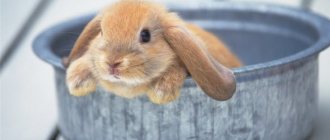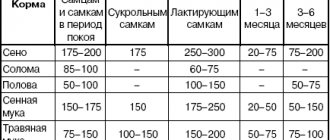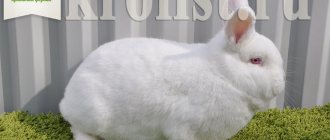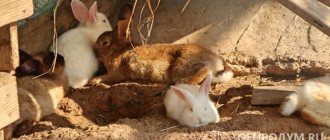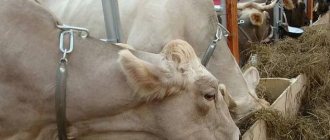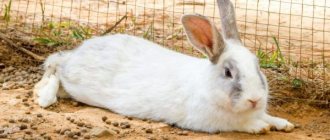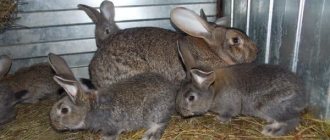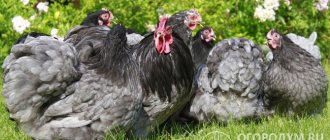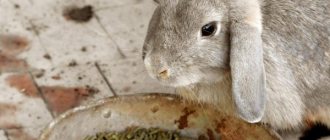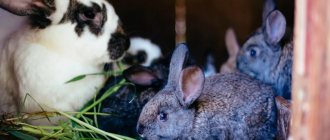The albino rabbit is especially highly prized. This is explained by the fact that in such animals, during the breeding process, the gene responsible for white color is more often suppressed by genes for gray and black color. Accordingly, it is quite difficult to breed completely snow-white animals. But, nevertheless, German and Belgian breeders succeeded in this at one time. And proof of the success of their work is the white giant breed.
White rabbit is more valuable
Origin story
Pure white rabbits are quite rare in various breed lines. It is extremely difficult to get one like this through the selection process. Breeding a breed for which albinism is a characteristic feature is an even more difficult task. But this is precisely the goal that the breeders of one of the German institutes set for themselves. This direction of work was dictated by the needs of the fur industry, in which white fur was especially highly valued.
Albino rabbits of the Flanders breed (Belgian giant) were selected as the basis for the breed line over a period of time. These animals are predominantly gray in color, but in some individuals, due to genetic characteristics, the synthesis of melanin, which is responsible for this color, is disrupted. As a result, a snow-white rabbit with red eyes is born. It was these animals that German breeders purposefully selected to found a new breed. Over time, the characteristic became firmly established in animals and began to be passed on to subsequent generations. But with the development of the new breed, a number of negative aspects also appeared, including:
- weak immunity;
- extremely low fertility;
- inability to cope with harsh climatic conditions;
- weak endurance.
Breeders from Belgium managed to partially solve such problems, to which almost all the livestock were transported in 1928. But all the negative aspects in the breed line were finally corrected by breeders from the USSR. To increase the fertility of animals, the rate of their development and resistance to local harsh climatic conditions, they were crossed with representatives of the gray giant and chinchilla breeds.
As a result, crossing other albinos with a rabbit of Belgian origin yielded results, and the white giant firmly established itself on the territory of the Soviet Union. But, at the same time, the size and weight of the living creatures that she inherited from the Flanders suffered to a certain extent.
What diseases are congenital
Congenital eye diseases:
- cataract;
- glaucoma;
- corneal occlusion.
Pathologies are provoked by genetic changes caused by deviations in the pedigree or inbreeding.
Did you know? The physiological structure of a rabbit's visual organs allows it to see what is happening from behind without turning its head.
Cataract
The disease can be congenital or appear as a complication after an advanced stage of conjunctivitis or bacterial infections. The congenital disease progresses more often with an increase in glucose in the blood of the parent.
A characteristic symptom of the disease is an eyesore. Discharge from the orbits and swelling are less common. The symptomatic picture depends on the type of disease and the intensity of damage to the visual organ. There are 3 types of cataracts:
- immature - partial damage to the lens;
- mature - complete clouding of the lens of one or both eyes;
- hypermature —deformation of the lens.
The main treatment is surgical removal of cataracts. When cataracts are removed at an early stage, the prognosis is favorable. In advanced cases, when surgery is contraindicated, medications are prescribed, but such treatment is not effective. As a result, glaucoma or phacoclastic uveitis develops.
Glaucoma
Develops against the background of increased intraocular pressure. The pathology can be congenital or acquired during life. In rabbits, an increase in intraocular pressure is observed from the 3rd month of life.
The clinical picture is blurred. The only thing that gives away the disease is an unnaturally bulging eye. Animals suffer from severe pain, which is why the eye protrudes.
Treatment with vasoconstrictor drugs has no effect. The main therapeutic method is removal of the affected organ. Such individuals are not used to reproduce offspring.
Corneal occlusion
The etiology of occlusive processes in the cornea remains unclear. The main symptom is the formation of connective tissue over the cornea. More often, the disease is identified in males over 5 months of age.
The connective tissue is removed surgically. In advanced cases, the entire eye must be removed. To stop the development of infection after surgery, antibacterial drugs and hormonal agents containing corticosteroids are prescribed.
Description of the breed
White giants have an impressive appearance. They inherited their large dimensions from Flanders, who is considered the world record holder in terms of weight.
White giants have an impressive appearance
The average weight of albinos is from 3.5 to 6 kg. The large weight is complemented by body length, which often reaches 60 cm. The main body features of the breed include:
- elongated dense body;
- wide chest, reaching 40 cm or more in girth behind the shoulder blades;
- elongated, large head;
- rounded, straight ears, the length of which is 15 cm;
- tightened, strong paws, which are set quite widely relative to the body, and therefore the animals can better handle a large body.
As for color, all purebred offspring without exception have fur that is ideally white. Certain inclusions, a yellowish or grayish tint of fluff can be traced only in those individuals that were born in the process of crossing with other varieties of rabbits.
Completely red eyes of an animal are also a characteristic feature of a violation of melanin synthesis. Due to the absence of such pigment, the iris becomes completely colorless. Therefore, the blood vessels located underneath are easily visible from the outside. They provide the red color to the eyeball.
In addition to the obvious signs of the breed line’s exterior, there are two more features that deserve attention:
- Poorly developed fur on the limbs. This characteristic, combined with a large body mass, implies certain inconveniences in keeping animals. If a rabbit is kept in an enclosure with a slatted floor, it will quickly develop corns, which are quite difficult to get rid of on your own. Therefore, it is better to make the flooring in the cage from solid materials.
- Dewlap in females. This element of appearance does not appear in all animals. This is why, after comparison, many breeders confuse it with a double chin. Perceiving this as a consequence of overfeeding, they begin to sharply reduce the caloric content of their diet. In fact, such formation has nothing to do with obesity and, on the contrary, is a sure sign of the rabbit’s excellent health.
Content
For breeding such rabbits, especially spacious cages are used. They should have a simple design that will make daily cleaning as easy as possible. The floor of such a cage must be made of solid material. You should also immediately install a large drinking bowl and feeder inside.
The enclosure must be divided into two halves. The first one is open. The animals will walk in it during the day. The second half is a shelter closed on all sides for females and young animals.
It is recommended to keep both young and adult livestock exclusively outside. Summer heat and mild winter frosts allow animals to quickly harden their bodies, which significantly reduces the likelihood of illness. Animals should only be moved indoors if the temperature drops below -20 degrees. Such air cooling is already fraught with frostbite.
Keeping young animals
As for keeping baby rabbits of this breed, they should be handled with extreme caution during inspection and transportation. Their bones and spine are fragile and can be easily damaged. In addition, babies gain weight much faster than their bone tissue can strengthen. Therefore, if a baby rabbit is frightened, he may break his leg by making a careless sudden movement.
Productivity
The large weight of white giants is the main reason that such animals are bred to produce valuable dietary meat. The yield of rabbit meat from one head, 65 days old, is 47%. If proper feeding is observed, this figure increases to 59-60% by the 275th day of the animal’s life. At the same time, livestock meat products are in high demand due to their delicate texture and excellent taste.
There is a high demand for the skins of this breed of rabbits
But of course, such rabbits are raised not only for their meat productivity. There is a high demand for the skins of this breed of rabbits. They are distinguished by high density, silkiness and softness of the pile. A wide range of different clothing items and accessories are produced from such raw materials.
Reference. According to the results of the research, it was revealed that on an area of 100 sq. mm of rabbit skin grows an average of 18-22 thousand hairs. At the same time, there are about 20-23 downy hairs for each core villus.
Preservation of the White Giant breed
Since rabbits can very quickly lose their breed qualities, if there is incorrect breeding classification, errors in feeding and maintenance, you need to constantly be on the alert and ensure that the breed is kept clean. They monitor the most obvious deviations from standards, which are easy to detect even for a non-professional. They look at two main parameters:
- skin defects (fur is a genetically fixed characteristic of the breed),
- slaughter weight (a decrease in the weight of a rabbit after slaughter is evidence of the degeneration of the breed).
Specific examples of deviations from the White Giant breed standard:
- uneven hairline;
- the appearance of fluffy fur (non-standard fur color);
- reduction in early maturity and slaughter yield in 90-120 days by more than 56-59%.
If the live weight of a rabbit before slaughter is 5.1 kg, then the carcass should not be less than 3.0 kg. this is a signal that the breed is reducing its potential.
Feeding
The diet of rabbits can and should be varied. Only in this case will it be possible to provide the animal’s body with all the nutrients and vitamins necessary for normal functioning.
Throughout the year, the main component of the white giants’ menu should be high-quality hay. Such food normalizes the functioning of the gastrointestinal tract of animals, promotes the growth of muscle mass due to the content of large amounts of protein and vitamins. But when feeding rabbits with such food, a number of points must be observed:
- Feed your pets exclusively fresh hay;
- You should periodically check supplies for the presence of mold and signs of rotting, and if they are found, exclude such food from the rabbits’ diet;
- harvesting must be carried out on lawns and clearings, as far as possible from the roadway and industrial enterprises.
In the spring and summer, rabbits must be fed fresh vegetation. Meadow clover, leaves and stems of dandelions, burdock, and sow thistle are beneficial for their body. You can also collect young nettles. But collecting herbs from a meadow is allowed only if the owner of the animal knows exactly what each specific species looks like. Otherwise, you can mistakenly prepare poisonous greens, which can lead to a number of intestinal diseases.
To avoid this risk, use fresh green food from plants growing in the garden. Rabbits and adult livestock happily eat the leaves of sunflowers, tomatoes, melons (melon, watermelon, zucchini), and pepper.
It is advisable to include the following vegetables and fruits in your diet:
You can also feed banana pulp and skins to animals. But their consumption must be limited, as in large quantities they cause stomach upset.
Many livestock owners use foliage and branches of various trees when feeding. But the choice of such food should be approached responsibly. The leaves and shoots of apple, pear, and acacia have a good effect on the digestion and health of rabbits. But you should not feed the animals oak greens. It can cause diarrhea in them.
Vinaigrette for rabbits
Another useful component of feeding white giants is the so-called vinaigrette. This mixture is prepared as follows:
- Fresh grass and tree foliage are chopped (not very finely) into an enamel bowl.
- Cut waste from vegetables and fruits is also added there.
- All this is thoroughly mixed and poured with boiling water.
- The entire contents of the container are boiled for two hours, filtered and the food is allowed to cool.
Rabbits eat this food with pleasure. It is rich in nutrients, vitamins and significantly enhances furry growth.
Care
First of all, you need to choose a good cage for them. Since New Zealand rabbits are enormous in size, they need a large “house” so that they can stand and even run. These animals need a home measuring at least 120x60x60 cm. Care should be taken to ensure that the bottom is durable and can support a pet whose weight is about 5 kg. There should be a lot of hay in the cage.
Reds are the founders of the breed, this color was the first to be bred
Due to its enormous size, it is inconvenient to keep such an animal in an apartment. But if a child wants this pet, then it is quite possible to have one in a spacious country house. Only when the animal is walking around the house should you keep an eye on it, because the long-eared animal can damage the cable with its teeth.
New Zealanders have a good coat, so it requires care. It needs to be brushed regularly. To prevent the rabbit from being afraid of this procedure, it is best to start combing it when it is still small. Sometimes tangles can form on the fur. Then special cosmetics are used that will soften this procedure. But if the tangle cannot be combed out, then you will have to cut it off.
There are no special nutritional requirements. The New Zealand rabbit is fed everything that other species do. The main thing is that the food is varied and contains vitamins. In the summer they are fed with grass (plantain, burdock, clover, dandelions are suitable) and leaves from trees. In cold weather, it is useful to offer this breed of rabbits pumpkin, hay and feed. Don’t forget to include grain crops and coniferous branches in their diet. It is necessary to always have a salt stone in the cage.
There is no need to intensively feed your New Zealand rabbit with fruits and vegetables. They are given to the animal in limited quantities and monitored to see if this or that fruit has caused an upset stomach in the pet.
It is important that the eared dog does not overeat, because this leads to obesity. To keep your rabbit in shape, it is useful for him to take walks from time to time. New Zealanders are fed 2 times a day
For example, if it is granular food, then it is 150 to 200 grams per pet. The evening food volume should be slightly larger than the morning one, because at night long-eared animals eat 70% more food than during the day
New Zealanders are fed 2 times a day. For example, if it is granular food, then it is 150 to 200 grams per pet. The evening food volume should be slightly larger than the morning one, because at night long-eared animals eat 70% more food than during the day.
Black New Zealand rabbits are smaller and calmer than their counterparts of other colors.
You cannot feed animals with rainwater or water from a river, otherwise they may get sick. You should also not give them boiled water, since it is devoid of oxygen and minerals.
Breeding
Puberty in females and males of albinos occurs 4 months after birth. But, most breeders agree that they should be allowed to mate no earlier than the 6th month. Sexual hunting occurs regularly in rabbits.
Female rabbits produce up to 10 babies per litter. One female has about 6 litters per year. Moreover, she is ready for repeated mating within 2 days after the birth of the offspring. Female rabbits are distinguished by their developed maternal instinct. They constantly warm the young, they do not have the habit of eating newborn rabbits. In addition, 240-250 g of milk is produced in the mammary gland of a female rabbit per day, which is quite enough to feed the offspring. But, such a volume of colostrum is formed only if the diet is properly selected.
Rabbits are left with their mother until they are 2 months old. After this, the babies are weaned.
A large number of domestic specialized enterprises are engaged in breeding albino rabbits. Such pets are not uncommon in small farms. The reason for this is the snow-white skins of animals, which are highly valued by fur factories, as well as dietary meat with high taste. But when breeding white giants, you should first familiarize yourself with the peculiarities of their maintenance and feeding.
Rabbits are beautiful, fluffy animals. Since ancient times, they have been bred as pets and useful agricultural animals. Rabbits have valuable, nutritious meat, as well as soft, warm fur, which is always in high demand. In addition, many types of rabbits are bred simply for aesthetic pleasure, as pets. They are very smart and sweet. This article presents the most popular rabbit breeds in different areas.
Flash of red eyes
"Flashing red" is not actually an eye color, even for rabbits. Instead, this is what happens when rabbits are photographed with flash.
What causes this phenomenon? Simply put, rabbits do not have a tapetum lucidum, a special layer of tissue that is usually found in the eyes of many other animal species, including us.
When a rabbit is photographed with flash, the bright light reflects directly off the retina because it does not have a tapetum lucidum. This causes rabbits' eyes to appear unnaturally bright red in photographs, just as they do in humans.
Meat rabbits
Meat breeds of rabbits are bred on large and small farms. They produce a lot of delicious, healthy, dietary meat, which is why the best meat breeds are highly valued.
Photo of California rabbit
- The California rabbit has a short body. The skeleton is light, but formed correctly. The muscles are well developed. Average weight – 4-5 kg. The legs are short but strong. The head is medium with small, erect ears up to 11 cm. The nose is hump, the eyes are scarlet. The coat is thick and white over the body, but the ears, paws, nose and tail are always dark. During pregnancy, the female gives birth to 8 rabbits.
Photo of the Soviet chinchilla rabbit
Photo of Black-brown breed of rabbits
White New Zealand Eared Ears
In areas where rabbit breeding is active, white New Zealanders are extremely successful. This variety of the breed was obtained through the selection of albinos, later bred with Belgian giants. As a result, individuals were obtained whose characteristics include such definitions as a strong skeletal system, developed muscular apparatus and a snow-white skin.
New Zealanders with a white coat are significantly larger than their red relatives. They are bred to produce dietary meat with excellent taste, as well as white skin. NZB fur is in great demand among fashion designers. This can be explained by the fact that any paint is evenly distributed on it. For example, in Hungary, white rabbits of the New Zealand breed produce up to 30 rabbits as offspring. And the females of this breed have enough milk to keep the rabbits well-fed.
Giant rabbits
Large breeds of rabbits are attractive to breeders due to their large body weight. From such animals you can get a lot of meat and skin. Of course, in order for the breed to live up to expectations, it is necessary to choose the best of the best.
Photo of the gray giant rabbit
- The Gray Giant is a Ukrainian breed of rabbit. The head is stretched, the ears are not hanging. The length of an individual can reach up to 65 cm. Weight is approximately 4.5-6 kg. The chest is up to 40 cm in volume. Fluffies have long legs and a massive pelvis. The fur is predominantly gray with hints of black or brown. The female gives birth to approximately 8 rabbits at a time.
Photo of the White Giant rabbit
Photo of Belgian Flanders rabbit
Brown eyes
This may come as a surprise to many as it is far from what we typically see in the media and in pet stores, but brown eye color is actually the most common eye color for many common rabbit breeds.
Some of the most popular breeds of rabbits with this eye color are black silver martens and sable martens. Many rabbits with brown, black and red fur also have brown eyes. Even white rabbits can have brown eyes, although they tend to be less common, which is why they have their own special nickname in the rabbit breeding world: brown-eyed whites, or BEWs.
Down and fur rabbits
Down and fur breeds are bred to produce high quality fur, fluff or pelt. They require painstaking care, because these animals often stain their valuable fur. A description of the breeds of downy rabbits that are in great demand among breeders is presented below.
Photo of an Angora rabbit
- The Angora rabbit is a famous species. Highly prized for its excellent wool. The body is small, the legs are strong. The head is medium in size with short ears. Weight approximately 3-5 kg. The coat is long, very thick, white, gray, beige, although other colors are allowed according to the standard. The wool is usually clipped or combed. Cut from one individual - 200 g.
Photo of a Rex rabbit
White fluffy breed of rabbits
This category also includes rabbits such as the White Giant, Ram, etc.
Features of the view
Buyers often confuse the concepts of “dwarf” and “decorative”. These words cannot be called synonyms at all. Any rabbit that is kept as a pet is considered decorative.
Dwarfs are small fluffy creatures. Such animals comply with the breed standard and have strictly acceptable colors.
Decorative breeds of rabbits
Decorative rabbits are bred in apartments and private houses as pets.
Photo of Butterfly rabbit
- Butterfly is an interesting, popular type of domestic rabbit. Weight approximately 4.5 kg. They have a small body. The head is disproportionate to the body, with even ears. The back and chest are wide, the legs are long. The fur coat is downed, very soft, light in color, but there are also black spots. And the nose and ears are usually completely black. During pregnancy, a female rabbit gives birth to 8 animals.
Photos of Vienna Blue Rabbits
- The Viennese blue rabbit is a small animal up to 4.5 kg. The bones are small and regular in shape. The head is not large with round cheeks and small ears, rounded at the ends. The paws are straight and strong. The fur coat is very thick, rich gray with a blue tint. There are about 8 cubs in one litter.
Photo of a Ram rabbit
Also in this category it is worth including such breeds as Rex, Ermine, and Soviet Marder.
Cages for keeping Viennese white rabbits
Rabbit cages, if you have your own farm, are made from various materials that are on hand. In common cages, a mesh is placed in front and the floor is also made of it; in nesting compartments, the floors are made of wood without gaps. In the uterine wards for Vienna White rabbits, such a floor is needed so that the rabbits do not fall through the mesh and the female rabbit can take a break from the mesh floor. The doors in such compartments are made of plywood, for a quiet rest for the rabbit in a shaded space.
If there is no uterine compartment, a nesting box with a round hole at the bottom and a removable lid at the top is placed in the cage.
What breeds of rabbits are bred in the Moscow region
Different types of rabbits have their own nuances in terms of immunity and care requirements. Recommended breeds for breeding may vary depending on the region. For example, in central Russia the climate is quite warm, but summers are not hot. For this reason, almost any breed can be bred in the Moscow region. The temperate climate makes it possible to achieve the highest performance indicators for meat, down, and fur species.
You can find suitable rabbits in this region on livestock farms and large, industrial farms, “Ruza-MIAKRO”, “KFH Shcherbakova A.E.”, “LPH of the Ivanov family” and the like.
Video
We invite you to watch several videos detailing the various features of New Zealand rabbits and comparing their productivity with their outbred “relatives”:
Loving husband and caring father. A versatile person, interested in literally everything. Gardening themes are no exception. I'm always happy to discover something new and share it with other people. He is of the opinion that nature is a second home for every person, therefore it should be treated with respect.
Found a mistake? Select the text with the mouse and click:
Humus is rotted manure or bird droppings. It is prepared like this: the manure is piled up in a heap or pile, layered with sawdust, peat and garden soil. The pile is covered with film to stabilize temperature and humidity (this is necessary to increase the activity of microorganisms). The fertilizer “ripens” within 2-5 years, depending on external conditions and the composition of the feedstock. The output is a loose, homogeneous mass with a pleasant smell of fresh earth.
“Frost-resistant” varieties of garden strawberries (more often simply “strawberries”) need shelter just as much as ordinary varieties (especially in those regions where there are snowless winters or frosts alternating with thaws). All strawberries have superficial roots. This means that without shelter they freeze to death. Sellers’ assurances that strawberries are “frost-resistant,” “winter-hardy,” “tolerates frosts down to −35 ℃,” etc. are deception. Gardeners must remember that no one has yet managed to change the root system of strawberries.
Both humus and compost are rightfully the basis of organic farming. Their presence in the soil significantly increases the yield and improves the taste of vegetables and fruits. They are very similar in properties and appearance, but they should not be confused. Humus is rotted manure or bird droppings. Compost is rotted organic remains of various origins (spoiled food from the kitchen, tops, weeds, thin twigs). Humus is considered a higher quality fertilizer; compost is more accessible.
Oklahoma farmer Carl Burns developed an unusual variety of multi-colored corn called Rainbow Corn. The grains on each cob are of different colors and shades: brown, pink, purple, blue, green, etc. This result was achieved through many years of selecting the most colored ordinary varieties and crossing them.
Natural toxins are found in many plants; Those grown in gardens and vegetable gardens are no exception. Thus, the seeds of apples, apricots, and peaches contain hydrocyanic acid, and the tops and peels of unripe nightshades (potatoes, eggplants, tomatoes) contain solanine. But do not be afraid: their number is too small.
You need to collect medicinal flowers and inflorescences at the very beginning of the flowering period, when the content of nutrients in them is highest. Flowers are supposed to be picked by hand, tearing off the rough stalks. Dry the collected flowers and herbs, scattered in a thin layer, in a cool room at natural temperature without access to direct sunlight.
One of the most convenient methods for preparing a harvest of vegetables, fruits and berries is freezing. Some believe that freezing causes the nutritional and health benefits of plant foods to be lost. As a result of the research, scientists have found that there is practically no decrease in nutritional value when frozen.
A new product from American developers is the Tertill robot, which weeds weeds in the garden. The device was invented under the leadership of John Downes (creator of the robot vacuum cleaner) and works autonomously in all weather conditions, moving over uneven surfaces on wheels. At the same time, it cuts off all plants below 3 cm with the built-in trimmer.
It is believed that some vegetables and fruits (cucumbers, stem celery, all varieties of cabbage, peppers, apples) have “negative calorie content,” that is, more calories are consumed during digestion than they contain. In fact, only 10-20% of the calories received from food are consumed in the digestive process.
https://fermhelp.ru/opisanie-porody-novozelandskij-krolik/https://krolist.ru/info/porody/novozelandskij-k.htmlhttps://ogorodum.ru/novozelandskij-krolik.html
Rabbits for breeding in the Tula region
In the Tula region, as in the Moscow region, the climate is pleasant and moderate. It is ideal for breeding rabbits, but where can you buy them? Many farms in this area breed rabbits. Among the most famous are the Zazino agricultural farm and the Giant Rabbits private farm.
Important! When any danger appears, the rabbit tries to immediately run away. But if this fails, he may begin to defend himself. With a blow from its strong paws, this small animal is capable of killing a small predator![/su_box]
Prevention of eye diseases
Preventive measures can solve most problems leading to eye diseases and include the following points:
- Regular disinfection of cages, drinking bowls, feeders.
- Examination of all animals by a veterinarian once every 3 months.
- Vaccination of rabbits from birth.
- Protection of cages and walking areas from the penetration of other animals.
- A complete diet, enriched with vitamin complexes.
- Organization of a drip system for drinking.
- Deworming once every 6 months.
- Isolation of new rabbits from the main stock for a period of 3 months. before conducting a full study to exclude infectious and genetic diseases.
- If there are sick individuals on the farm, they and the animals that were in close contact with them are moved into separate cages or sent to slaughter.
Did you know? A rabbit weighing 2 kg can drink the same amount of water as a dog weighing 10 kg.
Eye diseases in rabbits are caused by genetic abnormalities, infections and mechanical damage. In most cases, treatment is carried out through surgery.
If a rabbit's eye becomes cloudy and there is a general deterioration in its condition, it is necessary to immediately seat all the animals that were in contact with it separately and call a veterinarian. Do not try to solve the problem yourself - this can lead to complete loss of vision in the animal or the spread of infection to the entire livestock.
Rabbit breeds for the Kaluga region
"Yukhnov-Krol" is a famous plant in the Kaluga region for the production of rabbit meat. Breeds are purchased mainly from abroad and bred on the territory of the enterprise. Species such as French Hiplus, California rabbit, and Soviet chinchilla are bred here.
In addition, the APANYUK & Co rabbit breeding farm operates in the region. Here they professionally breed rabbits of various types, maintaining the purity of the blood of the breeds. At this enterprise you can purchase breeding specimens of the White Giant, Californians, Burgundy rabbits, Ram, Chinchilla, Risen and the like.
